Israel says all of its ships are accounted for.
Israel is disputing Hezbollah claims that it attacked an Israeli war ship.
***
A Lebanese official says security forces in the coastal city of Tyre heard "the din of an explosion in the sea" and saw "plumes of smoke billowing" from a burning ship.
Israel says none of its ships has been hit.
"We must be ready to dare all for our country. For history does not long entrust the care of freedom to the weak or the timid. We must acquire proficiency in defense and display stamina in purpose." - President Eisenhower, First Inaugural Address
Monday, July 31, 2006
Hezbollah says it has hit another Israeli warship; Israel issues denial
Ship strike/non strike reported here:
Modern warfare: the second front is the media
A nation at war must either be better at propaganda than their enemy or ignore the media and win the battles on the ground. In either event, it's no place for half measures. See here:
In a weird way, one of the factors that hurts Israel is that its people are protected from the unguided rocket attacks by their civil defense preparation- bomb shelters and safe rooms, anti-missile defenses. If Israel had lost 50 kids when a rocket had hit a school early in this skirmish, the world might be more sympathetic to Israel. But....when the rule is "if it bleeds, it leads" then the reprehensible tactics of Hezbollah in using human shields work.
The Israelis are losing this war because their government is fighting indecisively on one battlefield and not at all on the other. Because the Israelis aren't fighting the media war, the press is slashing at the Israelis hourly in a manner previously reserved for President Bush. Like the president, the Israelis are losing politically because the enemy is fully engaged on both fronts.Hezbollah is playing the media like a fine instrument, and despite Israel's post-event explanations, videos of dead babies trump videos of rockets being launched from the building housing the children.
In a weird way, one of the factors that hurts Israel is that its people are protected from the unguided rocket attacks by their civil defense preparation- bomb shelters and safe rooms, anti-missile defenses. If Israel had lost 50 kids when a rocket had hit a school early in this skirmish, the world might be more sympathetic to Israel. But....when the rule is "if it bleeds, it leads" then the reprehensible tactics of Hezbollah in using human shields work.
Navy Mine Warfare & ASW to merge commands
Reported here:
San Diego will become the hub of Navy mine-hunting this fall under a controversial plan to merge the program with a much bigger command.Given the Navy's typical resistance to any changes, the reaction is about what I'd expect. I suspect there's a lot of synergy that could make both ASW and mine warfare better.
The Mine Warfare Command – including 10 ships and about 1,200 sailors – is to be moved from Ingleside, Texas, to Point Loma.
The program's aircraft will be stationed in Virginia. The Texas base is being closed.
***
Supporters of the planned merger say it will align two parts of the Navy that have similar missions. They maintain that a merger will give the mine-warfare program access to high-tech wizardry, allowing it to replace an aging fleet of ships geared toward Cold War-era threats that no longer exist. Last month, the Navy decommissioned the first four of a dozen mine-hunting ships it intends to scrap by 2008.
“The time has come to put it all under one roof so we can leverage the technologies that are compatible,” Rear Adm. John Waickwicz told the San Diego Military Advisory Council in April.
Waickwicz is commander of the recently formed Fleet Anti-Submarine Mine Warfare Command.
***
Waickwicz sees mine warfare fitting nicely under the anti-submarine wing. After all, he said, both types of combat involve the detection and destruction of undersea weapons.
“There are a lot of technologies that can be used for hunting mines and anti-submarine warfare,” Waickwicz said. “We don't want to dilute capabilities. We want to increase capabilities.”
Those concerned about the merger said the opposite would occur.
Placing an independent command within a larger command inevitably would degrade it, they said. Critics cite the inclusion of the Federal Emergency Management Agency within the Department of Homeland Security, and the weaknesses exposed by Hurricane Katrina.
“They are turning back 15 years of planning and exercises,” said Truver, the naval analyst. “(Mine warfare) will truly become a backwater of the United States Navy.”
Mine warfare has always existed on the Navy's fringes, its slow-moving, coast-hugging vessels dwarfed by the bigger, faster oceangoing fleet.
Sunday, July 30, 2006
Hezbollah has a maritime force?
The Counterterrorism Blog cites to this report concerning a Hezbollah maritime force that has yet to be revealed in the current skirmish with Israel:
UPDATE:
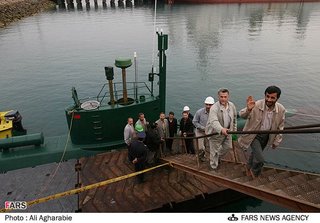 Of course, the Iranians have been building some mini submarines, as posted about by Bubblehead over at The Stupid Must Be Punished a few months ago here with photos from a Free Republic thread here. As noted in the various links Bubblehead has collected, the Iranian boat may be a copy of a North Korean design. One link Joel cites is Lawhawk who cites a newspaper article as reporting:
Of course, the Iranians have been building some mini submarines, as posted about by Bubblehead over at The Stupid Must Be Punished a few months ago here with photos from a Free Republic thread here. As noted in the various links Bubblehead has collected, the Iranian boat may be a copy of a North Korean design. One link Joel cites is Lawhawk who cites a newspaper article as reporting:
Keep an eye on this.
I suppose it would be easy enough to ship a small sub to Lebanon...
According to a senior officer in the Revolutionary Guards, who himself trained Hezbollah's navy units, the Party of God still has a number of surprises for the Israelis. The bombing of an Israeli navy vessel with two C802 missiles, with the assistance of Revolutionary Guards commanders present in Lebanon, was not a direct confrontation. Hezbollah, he said, has a submarine unit and a navy commando unit that operates Chinese-manufactured speed boats, capable of targeting the Israeli navy.Into the realm of pure speculation: Submarine unit? Naval commandos? What if Hezbollah has a version of a North Korean midget submarine? One site has a drawing here with the following characteristics:
M100-D Midget SubmarineLength : 18.8mSee also SpecWarNet.
Width : 2.7m
Displacement : 76t
Displacement (Under Water) : 88t
Draught : 2.5m
Main Engine : Electric Motor X 2 (Single Shaft : 68hp)
Max Speed : 6Kn
Max Speed (Under Water) : 7.4Km/h
Crew : 4 + 8
Special hatches were equipped in the bottom of M-100D Midget Submarine.
M-100D was able to take out the special attack team outside with no appear
on the surface of the sea. (emphasis added)
UPDATE:

 Of course, the Iranians have been building some mini submarines, as posted about by Bubblehead over at The Stupid Must Be Punished a few months ago here with photos from a Free Republic thread here. As noted in the various links Bubblehead has collected, the Iranian boat may be a copy of a North Korean design. One link Joel cites is Lawhawk who cites a newspaper article as reporting:
Of course, the Iranians have been building some mini submarines, as posted about by Bubblehead over at The Stupid Must Be Punished a few months ago here with photos from a Free Republic thread here. As noted in the various links Bubblehead has collected, the Iranian boat may be a copy of a North Korean design. One link Joel cites is Lawhawk who cites a newspaper article as reporting: However, a closer examination of the story, indeed from the Tehran Times itself, shows that the AP story overstates the capabilities.Which is exactly where Hezbollah wants to be operating and what they want to be doing.
A closer reading of the Newsday article would not find the following statement made in the Tehran Times article:Iran has started to manufacture midget submarines that can land troops and fire rockets, state media reported on Tuesday.
That's right - midget submarines that could land troops and fire rockets. Scary stuff. Not entirely. The subs would only work in littoral waters, not in open water, and their size would indicate that their primary use would be terrorist missions or covert operations.
Keep an eye on this.
I suppose it would be easy enough to ship a small sub to Lebanon...
Yachts with pirate protection

For the rich and paranoid, one more extravagence as reported here :
In a June attack in St. Lucia, documented on www.noonsite.com, a Web site for boaters, pirates boarded a yacht, beat one of the occupants until he lost consciousness, and raped his wife. In another attack off the coast of Venezuela, a yachtsman who tried to stop pirates from stealing his dinghy was beaten and left for dead, although he survived.Burger Yachts for those with the money.
Far from the scenes of carnage, Wisconsin yacht companies are playing a role in fighting piracy. Burger Boat Co., for example, has formed an alliance with SAFE, a Los Angeles firm that specializes in high-end residential and yacht security systems.
***
Burger officials won't disclose the security features of individual yachts. But the company's options list includes things such as bulletproof glass, "safe rooms" for hiding from pirates and high-tech weapons meant to kill intruders.
***
"In some areas, pirating is more likely to happen than not. You wouldn't take a boat there unless itwas fully armored and fortified," said Al Corbi, SAFE president.
Corbi has installed security systems in homes and yachts for more than 35 years. His clientele range from sports stars to royalty.
"Most of my clients are the types that have their seven homes and three yachts and two jets," he said.
Corbi has dozens of ways to make a yacht more secure, most of which he won't publicly disclose. His firm uses technology such as unmanned aerial drones and remote surveillance devices for identifying threats from a distance.
"We have been using things that the federal government is just now buying to test," Corbi said.
His firm also doesn't hesitate to arm yachts with lethal force, subscribing to the theory that sometimes it's necessary to kill your attackers and worry about the legalities later.
Yachts are easily big enough to be equipped with electrified fences as well as machine guns and lots of other weaponry.
"Let's just say that our company is one of the few that will do whatever it takes to protect the client," Corbi said.
***
SAFE's weapon systems are encoded with biometrics so that only very specific people can use them. That way, the weapons can't be used against the crew and passengers they're supposed to protect. It also leaves a permanent record every time a weapon is used.
Somalia gets a commercial flight
Gun smugglers is one thing, but a commercial aircraft flying intoSomalia?
Who'd thunk it? Wonder what sort of passengers are arriving? Somalia as a new tourist attraction? After all, Shar'ia law is fun for all...
The first commercial flight in a decade departed Mogadishu's newly reopened international airport Sunday, demonstrating how Islamic militants have pacified the once-anarchic capital and much of southern Somalia.
Local airlines had been operating from private airstrips outside the capital.
Now, Islamic militiamen are guarding the airport for commercial passengers, said Sheik Muqtar Robow, deputy defense chief for the Islamic group.
Who'd thunk it? Wonder what sort of passengers are arriving? Somalia as a new tourist attraction? After all, Shar'ia law is fun for all...
At rest: Master Diver Carl Brashear
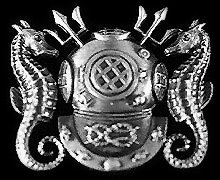
Taps for Master Diver Carl Brashear:
Brashear’s son Phillip, a Chief Warrant Officer 4 in the U.S. Army, who returned from service in Iraq on emergency leave to be at his father’s bedside when he passed away, spoke candidly about his father’s courage and character.I had the pleasure of meeting Master Chief Brashear in Norfolk a few years ago when I was up there on Navy business.
“He taught people world-wide that your race, your gender, your religion, none of that makes any difference,” said Phillip. “You can achieve your goals, you can be held accountable to your characteristics as a person not by the color of your skin.
I was wandering through the Navy Exchange looking at clothes when I was approached by a man who told me that he was looking for a suit that he could wear to the premiere of a movie that they had made about his life and asked my opinion about the choices at the Exchange. He introduced himself and even gave me a business card. We had a nice long conversation. We discussed a few divers we both knew and left on my promise to keep an eye out for his movie.
His story, as his son says, should be a lesson to all of us. My short discussion with him left me impressed with his quiet confidence.
A brush with greatness.
Rest in peace, Master Chief.
Cougar Ace Update: Salvage tug arrives, another enroute
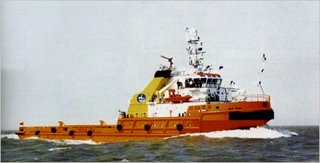
Reported here:
The Alaska Coast Guard has said that a salvage tug has reached the Cougar Ace, a disabled ship adrift 127 miles south of the Aleutian Islands.Photo is of typical ocean-going salvage tug - not of the one on scene.
Cougar Ace adrift
The ship, loaded with nearly 5,000 Mazda automoblies, was still listing sideways about 60 degrees in relatively calm seas 127 miles south of Amlia Island.
Sunday Ship History: The Battling Barracks Barge
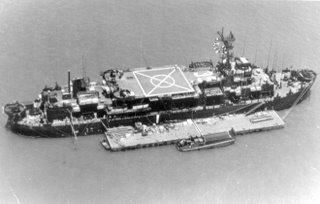
Somewhere in my past I spied the USS Benewah (APB-35) and thought her to be an ugly little ship. But that was before I learned more of the history of this "Battling Barracks Barge"...
The Navy built and used several types of barracks barges over the years, some self-propelled and others towed into place. In choosing to focus on a single unit no slight is intended to others ships and crews who served their country well and honorably. But choose I must, and I was vaguely familiar with USS Benewah, so this Sunday Ship History focuses on her.
Benewah started out on the planning board with the flat-bottomed hull of an LST (Landing Ship, Tank). The LST concept is said to have started with Winston Churchill. Benewah's official history does not refer to the inventor of the concept of the "Barracks Barge, Self-Propelled." Commissioned in 1946, too late for WWII, Benewah, served only a few months before being decommissioned herself. Her role, as might be gathered from her name, was to serve as living quarters for crews of ships and boats that, for a variety of reasons, could not stay on their own vessels. She was brought back to life in 1952, and deployed to the Mediterranean providing berthing for SeaBees. In 1953, Benewah became a flagship - for Commander, Fleet Air, Eastern Atlantic and Mediterranean, a role she played for a couple of years.
Soon laid up again, Benewah was brought back for use as berthing for precommissioning crews. But in 1967, Benewah joined the fighting Navy:
Following a week of training at the Naval Amphibious Base, Little Creek, Va., the ship put to sea for the Far East. After stops at Rodman in the Canal Zone and at Pearl Harbor, Benewah reached Vietnam on 22 April. Upon arrival, she became flagship for the Commander, Task Force (TF) 117, the Mobile Riverine Force operating in the Mekong Delta. Except for an occasional trip to Japan for repairs, Benewah spent the next 44 months at various locations in the Mekong Delta. In addition to serving as headquarters, she provided barracks space, medical facilities, stores issue, and a myriad of other services to the sailors and soldiers operating with the Mobile Riverine Force and with the similar formations that succeeded that organization when it was disestablished late in August of 1968. The barracks ship frequently suffered enemy fire, and her guns went into action on numerous occasions. In May and early June of 1970, Benewah participated in the incursion into Cambodian territory to support forces interdicting the Viet Cong supply lines running through that country.Much more on her Vietnam service is told here, at a website devoted to her Vietnam service with the Mobile Riverine Force . How well did she serve? A list of her awards gives some indication:
She received many awards and decorations for her Vietnam service: the Vietnam Service Medal; Vietnam Campaign Medal; three Presidential Unit Citations; four Navy Unit Commendations; four Meritorious Unit Commendations; three Republic of Vietnam Presidential Unit Citations; and the Republic of Vietnam Unit Gallantry Citation. In addition, she earned fourteen Battle Stars for her service "in country" Vietnam, making her one of the most decorated ships of the Vietnam War.Not to mention the Combat Action Ribbon...

Additional information here at the Mobile Riverine Force website:

Although she was obviously not a candidate for cruiser or destroyer duty, she was a far cry from the commissioned in 1946. An APB’s original armament consisted of two 20 millimeter gun mounts. In 1967, Benewah was outfitted with two quad-barreled 40 millimeter mounts, two 3’/50 installations and 20 strategically placed 50 and 30 caliber machine guns. In addition, she was equipped with 25 fiberglass assault boats, which were utilized by Army troops who made her their base of operations. A large helicopter landing platform was also built over her superstructure which was used for deploying troops and receiving casualties.Heck, even John F. Kerry spent some time on an APB (shown with Willam Rood. Kerry has the RPG launcher).
***
She became the Flagship for Commander, River Assault Flotilla One, Mobile Riverine Force Task Force-117 and Commander, 2nd Brigade, 9th Infantry Division. After a short stay in Vung Tau, the Benewah moved up river and began a series of combat riverine assault operations in the Mekong Delta. When the Navy Boat Crews and the Riverine Infantry embarked, the ship’s company increased from 160 to 1150 personnel on board. She participated in all Coronado Operations from I-XI, and played a large role during the TET offensive in 1968, moving from one spot to another. The 10,000th helicopter landing was made on her deck in the Fall of 1968 by the 9th Aviation Battalion.
***
Though the Benewah was the first "Green Ship" to serve in the Mekong Delta, as part of the Mobile Riverine Force, she wasn't alone. There were three more APB's - USS Colleton (APB-36), USS Mercer (APB-39) and USS Nueces (APB-40). There were 5 ARL's - USS Satyr (ARL-23), USS Sphinx (ARL-24), USS Askari (ARL-30), USS Indra (ARL-37) and USS Krishna (ARL-38) and many APL's and YRBM's. (quoted from Albert Moore at MRFA site)
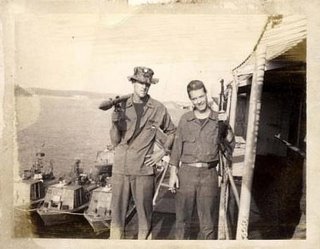 Nice bit of oral history here:
Nice bit of oral history here: It was much more exciting when I shifted over to the Mobile Riverine Force The staff was headquartered afloat on a barracks ship in the middle of the My Tho River, about six miles west of My Tho. In addition to the CTF117 staff and the River Squadron (RivRon) 9 and 11 officers and boat crews, the barracks ship was the berthing ship for a few hundred U.S. Army troops of the [Second Brigade of the] 9th Division out of Ft. Hood, Texas.In retrospect, the "ugly little ship" I saw in Subic in the early '70s was a real fighting ship. And one whose crew deserve a salute for their service.
The ship was the USS Benewah (APB-35). Positioning in the exact middle of the approximately 1,000-yard wide river was critical, because the banks and jungle along the river was not free of Viet Cong infiltration. Of course, in South Vietnam nothing was VC-free. The navigator and quartermasters on the Benewah learned their "positioning" lesson well, due to a life-threatening attack on the night of March 20, 1968. Because of suspected underwater sapper (VC intruder) activity, the Benewah had just been moved to what was deemed to be a safer location closer to the large U.S. Army base at Dong Tam, northeast of My Tho. The My Tho River was a bit narrower there, but thought to be safer. I was asleep, and awakened by a loud explosion. It was a little after midnight when the Benewah was struck by two 75-mm recoilless rifle rounds; one below the waterline and the other impacted on the 4th deck portside forward. The armor-piercing shell penetrated through four, steel bulkheads and exploded in the mess hall. The Benewah with its magazines loaded with ammunition and highly volatile fuel storage tanks was a juicy target, but on that night it was spared catastrophic damage.
In one of those miracles or quirks of war, no one was injured, because no one was having midnight rations at that time. This was unbelievable because the duty watch had just rotated, and most sailors usually cycle through the mess decks for coffee or a sandwich. But not on this night. There were no casualties. It didn't take very long to reposition Benewah to a wider and safer part of the river.
Photo of gun in action by Tom Duthie 4th/47th 1967 from the MRFA website. The photo of the "parade of ships" is of a pass-in-review honoring the awarding of the Presidential Unit Citation.
USS Neuces (APB-40) history.
UPDATE (8/1/06) And the battling YRBM-18.
Saturday, July 29, 2006
"Sudden turn" lawsuits begin
Malacca Strait Pirates kidnap Thai fishermen, demand ransom
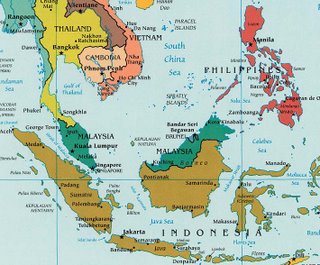
Reported here:
Three Thai fishermen based in Kuala Perlis were abducted by pirates in the Straits of Malacca last Thursday.
The pirates have demanded a RM144,000 (400 million Rupiah) ransom for the fishermen who were kidnapped from two boats about 67 nautical miles from Langkawi.
UPDATE: Langkawi location map:

I'm shocked: "Pirates are real"

What is about piracy that it doesn't seem to sink in with people that it is a real menace to commerce and to lives? A report from the front lines here:
Attacks by all-too-real modern pirates have increased by 168 percent in the past 10 years. Armed with ship tracking systems, speedboats and rocket-propelled grenades (RPGs), these seagoing bandits are enjoying an unlikely renaissance.
***
Modern pirates use intelligence (often tip-offs from corrupt port officials), satellite phones and tracking technology to plan attacks on valuable cargo, but one tool of modern pirates remains the same: the rope and grappling hook. Storming a ship in motion requires special forces-style skills and many in the shipping industry believe some of the more sophisticated modern pirates are rogue military units. A relative absence of risk is also behind the rise in piracy, according to Newton.
"We don't carry armed guards and nobody is going to pursue you because it is international waters and no one has jurisdiction," he says. "Once they get on board, there is nothing you can do if they are armed and you are not. As captain, the last thing I want is for my crew to get hurt."
Another reason why piracy is so risk-free is that many victims fail to report the crime. Shipping companies would rather bear the loss of US$20,000 stolen from a safe than report it to their insurers and face a hike in premiums. Insurance premiums rose by 300 percent for vessels entering Yemeni waters after a suicide boat rammed into the Limburg, a French oil tanker, in October 2002.
***
According to Mukundan, naval vessels are willing to discourage pirates with a show of force, but rarely want to capture and detain pirates in international waters. The US navy recently caught and detained pirates who attacked a Thai fishing vessel near Somalia, but eventually had to release the men because neither the Thai government nor any other would put them on trial. Where ships have been seized and crews kidnapped off Somalia, shipping companies simply pay the ransom demands of pirate militia.
Just as traditional pirates can symbolize the inequalities of the early imperial era, so modern pirate activity is founded upon economics. About 90 percent of world trade is carried by sea. Cost-cutting has made modern cargo ships more vulnerable than ever to attack, according to Numast, the ship officers' union in London's East End.
Pay the Somali pirates; get crew released

Somali pirates release South Korean crew after ransom paid, it says here
Somali pirates released a South Korean fishing boat with 25 Asian crew, on Saturday, after a ransom of hundreds of thousands of dollars was paid.The effect of paying huge ransoms was not discussed, but I suspect it encourages more piracy.
"The illegal fishermen who unlawfully entered into the territorial waters of Somalia were released after they paid a fine of $800 000," elder Abdi Ilmi told AFP from Haradere, about 300km north of Mogadishu.
The released crew of the 351 ton Dongwon-ho No628, owned by Dongwon Fisheries, were kidnapped in April.
Outstanding video of threat to Israel from the sea

Excellent report by Wolf Blitzer on CNN. Video here.
Cross posted at Milblogs.
See also earlier post on Israel and terrorist swimmers.
UPDATE:

One form of Israeli response - the anti-terror unmanned surface vehicle Death Shark.
But the true mission of the "death shark" is to defend Israel waters, her civilian coastline and her allies from a terrorist attack.
The IDF said that it plans to deploy it for dangerous tasks, such as monitoring the coast for suspected infiltrators. Palestinian terrorists have detonated themselves a number of times next to Navy patrol boats, and the Navy has long sought a safer way to approach suspicious sea craft at sea.
Friday, July 28, 2006
Israel and terrorist swimmers
 There have been several attempts by swimming terrorists to enter Israel and sow havoc. In recent years, these efforts have not been successful as noted
There have been several attempts by swimming terrorists to enter Israel and sow havoc. In recent years, these efforts have not been successful as noted herefrom a 2004 event:
Israeli soldiers killed two armed Palestinians dressed in diving uniforms who attempted to infiltrate a Gaza Strip settlement from the coast, the army said yesterday, the latest in a series of failed attempts to avenge Israel's assassination of the Hamas spiritual leader.I suspect Israel is well aware of the threat and closely watches its shores.
Initially, the army said three Palestinians had been killed. After searching the area in daylight, a spokesman downgraded the death toll, saying only two bodies were found near the Tel Katif settlement.
The two militants -- who opened fire on an army outpost guarding the settlement shortly before midnight Thursday -- were wearing diving uniforms, and flippers were found thrown on the coast, the army said. The men were armed with assault rifles and rocket-propelled grenades, the army said.
In August 2002, militants also attempted to infiltrate from the sea the Dugit settlement in the coastal strip. The militants were killed before they reached shore.
Israel's oil supply

In conjunction with an earlier post on the effect of the Israeli sea blockade on Lebanon -especially on oil supplies for Lebanon's power plants, and as the result of an e-mail from Glenn Germaine (his companies are Seaward Services and Cetacean Marine), suggesting the topic - let's look at Israels' oil supply...
We know that Israel has asked the U.S. for jet fuel as reported here:
The Pentagon notified Congress July 14 of an Israeli request to purchase up to $210 million in JP-8 aviation jet fuel for its military aircraft.This would seem to indicate some oil issues. Israel's oil supply situation is well-described here:
”The jet fuel will be consumed while the aircraft is in use to keep peace and security in the region,” the Pentagon’s Defense Security and Cooperation Agency said.
From Russia and former Soviet republics. Israel produces only a couple thousand barrels of oil a day, which means it relies on the global market for more than 99 percent of its consumption. It's difficult to name all of the country's suppliers—in 2004, Israel's minister of national infrastructures admitted that "Israel's situation is complicated. We don't have diplomatic relations with most of the countries from which we import oil." But over the past 25 years, significant fuel imports have come from Angola, Colombia, Mexico, Egypt, and Norway. In more recent times, the Israelis have turned to Russia, Kazakhstan, and some of the other -stans for the bulk of their oil.The Slate piece also refers to a Memorandum of Agreement under which the US agrees to provide oil if needed to Israel, but I note that the dates therein indicate the MOA should have expired.
***
The Israelis have also tried to ramp up their own fuel production. A few weeks ago, they got some press for developing a new way to extract energy from the country's large reserves of "oil shale."
Israel has two refineries, one at Haifa that has temporarily reduced capacity (see here) because it is a target of Hezbollah rockets:
Hezbollah earlier claimed it was targeting the refinery.The other Israeli refinery is in Ashdod. The Ashdod refinery also figures into the oil shale extraction process, as set out here.
"The resistance fires rockets on the oil refinery in Haifa, north of
occupied Palestine," Lebanese Hezbollah satellite station Al-Manar reported on
Sunday.
In sum, Israel buys the bulk of its oil on the open market. In the current situation, except for the persistent rocket attacks on Haifa, there is no known restriction on importing oil into Israel by ship. As to the sources of the oil- well, oil is very fungible and in the real world, the source is really not that significant compared to a steady supply. As for the JP-8 request, that may be due to the refinery cut back or to other issues.
Impact of Israeli Naval Blockade
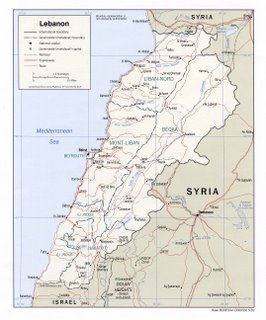
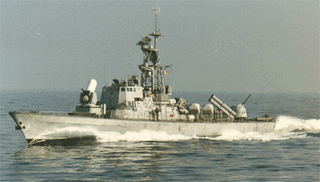
Israel's naval blockade of Lebanon is having an impact as reported here:
As the Israeli military blockade of Lebanese ports enters its third week, officials here say they are running critically short of fuel for power plants.Israel has opened the blockade to allow evacuations of foreigners from Lebanon and to allow the inflow of some humanitarian supplies, see here.
"All our power generation depends on fuel oil," Public Works and Transportation Minister Mohammed Safadi said Thursday. "We are five days away from running out."
***
Attacks on the key Jieh power plant 20 miles south of Beirut caused a massive oil spill that has coated 50 miles of Lebanese coastline. The popular Ramlat al Baida public beach in west Beirut is covered with a 10-foot band of black tar.
"This is a catastrophe I wouldn't wish on any country in the world," Environment Minister Yacoub Sarraf said. Attempts to gauge the extent of the spill, Sarraf said, have been complicated by the air and sea embargo that prevents him from viewing it by plane or boat.
"I am not even allowed to go out in a patrol boat," he said. "I've had to resort to calling captains on ships at sea to find out what they have observed."
Sarraf said he sent a frantic appeal this week to the U.N. Mediterranean Action Plan environmental program in Athens for help with the cleanup. But the program's coordinator, Paul Mifsud, said nothing could be done until the fighting had ended.
"The extent of the pollution and the type of pollutant would call for a complex and long shoreline cleanup operation," Mifsud said. "However, international assistance could be considered only once the hostilities in the area have ceased."
The most pressing problem facing the country is the looming electric power shortage that threatens hospitals, government buildings and residential neighborhoods.
Other Maritme Mishaps and Adventures
The world will get a chance to find out the effect on a coral reef of tons of sugar being pumped on it, as reported here. The Zhi Qiang carrying a load of sugar, smacked into a reef off Papua New Guinea and, in order to free the ship, the suger had to be dumped. If we see coral with lots of cavities, we know what to blame.
And in the US, a 670 foot ship had steering troubles and ran aground off Mayport, Florida, as set out here:
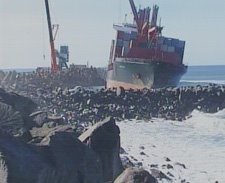
At the port of East London, South Africa, a cargo ship ran aground several weeks ago as it was leaving port. Cargo, fuel and other oils have been removed to try to lighten the ship for removal from the rocks (and it's well up on the rocks- see photo). Most recent indications, here, are that the ship will be removed, but no one seems quite certain as to how that will be accomplished.
Dismantling old ships is much in the news, as evidenced by "ghost ships" stories from England and a "toxic ship" story from Turkey.
In England, 13 former U.S. Navy ships are awaiting scrapping amid some controversy, as reported here and here. Why ae the U.S. ships in England? The latter link reports:
Turkey has something of similar problem, as the Netherlands is sending a "toxic" ship its way, as reported here and Turkey has agreed to accept it over the howls of environmentalists. And Turkey has its eye on a bigger ship dismantling prize:
And in the US, a 670 foot ship had steering troubles and ran aground off Mayport, Florida, as set out here:
The Horizon Discovery, a container ship, ran into rocks at the Little Jetties Park off Ocean Street Tuesday night. Early reports indicate mechnical failure caused the problem.

At the port of East London, South Africa, a cargo ship ran aground several weeks ago as it was leaving port. Cargo, fuel and other oils have been removed to try to lighten the ship for removal from the rocks (and it's well up on the rocks- see photo). Most recent indications, here, are that the ship will be removed, but no one seems quite certain as to how that will be accomplished.
Dismantling old ships is much in the news, as evidenced by "ghost ships" stories from England and a "toxic ship" story from Turkey.
In England, 13 former U.S. Navy ships are awaiting scrapping amid some controversy, as reported here and here. Why ae the U.S. ships in England? The latter link reports:
An American subsidiary of Able UK won the contract to recycle 13 of the obsolete ships, and chose to carry out the work at Able's Hartlepool shipyard.Concerns are, of course environmental and include issues of lead, asbestos, mercury, etc.
Environmental campaigners say the US has the technology to do the work.
But the UK's Environment Agency initially agreed to the transfer on the basis that all approvals were in place.
It subsequently transpired they were not - so new consents must be sought.
Turkey has something of similar problem, as the Netherlands is sending a "toxic" ship its way, as reported here and Turkey has agreed to accept it over the howls of environmentalists. And Turkey has its eye on a bigger ship dismantling prize:
France is searching for a country to disassemble its 270 retired war ships. “They came and we showed the facilities. If we could only reach an agreement;,so the Turkish economy could earn income from the deal.”
Cougar Ace Update: Ship leaking fuel?

Reported here:
A Mitsui O.S.K. cargo ship, listing in rough seas near Alaska's Aleutian Islands, might be leaking fuel from its tanks, the U.S. Coast Guard said.You are invited to find an appropriate salvage tug and race the Crowley team to the Cougar Ace to vie for salvage rights...
"Observers have reported a light and broken sheen extending two miles around the vessel" carrying 430 metric tons of fuel oil and 112 metric tons of diesel, the Alaskan office of the Coast Guard said in a statement on its Web site.
The Coast Guard, which did not clarify who the observers were, said its own personnel found "no signs of the vessel's fuel tanks losing containment at this time."
***
A team from salvage company Crowley Marine is due to reach the location of the Cougar Ace, about 230 miles (370 kilometers) south of the Aleutian Islands, on Wednesday, with the aim of towing the ship to a nearby port, the Coast Guard said.
UPDATE: Cougar Ace history posts: #1,
#2, #3. You are reading #4.
Container shipping rates fall: Law of Supply and Demand at work

Classic result of the Law of Supply and Demand at work as set out here:
As bigger container vessels enter into service, the container shipping industry is beginning to feel the pinch as demand has not picked up as much of late, says Winston W.F. Loo, managing director of Barwil Unitor Ships Service Malaysia.Except, of course, that some firms, unable to make money in a excess capacity market, will lay up their less efficient ships and capacity will decrease as a result.
***
On the local front, he said rates had dropped like about 19 percent at the end of first half of the year compared with the last quarter of 2005.
When compared with first quarter of 2005, the drop has been in excess of 30 percent, he disclosed.
Base Ocean Rates to Europe in the local market currently have been hovering between US$700-750 per TEU (twenty-foot equivalent), way below rates of US$1,200 - 1,300 per TEU during the heydays of 2004/05 period.
***
On the other hand, he felt that there was still a problem affecting the container industry, especially with the mis-match in timing of these large vessels entering into service as they were ordered during the good times of 2004 and 2005.
But he conceded that "you can't order for ships today and get them tomorrow", adding that there has to be a considerable time lag before the ships could come into service after they had been ordered.
Loo believed that competition is expected to intensify as bigger vessels like those with a capacity of 9,600 TEUs by China Shipping and the 12,000 TEUs ships of Maersk Line, amongst others, coming into service.
"The (start of the) second half of the year is not looking good given that the summer season is usually a period whereby volume would actually start to taper off, with the rebound coming in late August or September before tapering off again for the year end festivities in November," he said.
Between now and 2008, more large container vessels are expected to come into service.
"The scary part is whether there is enough demand to take-up the ample space (in the vessels)," he told Bernama in a recent interview.
Loo said it was forecast that the available container capacity worldwide would expand by about 50 percent between 2006 and 2008.
As a booming economy, he felt that if China could take up much of the capacity being injected to the industry, shipping rates could be maintained at current levels.
If not, he believe they could come down further.
Thursday, July 27, 2006
Somalia: One reporter's take
An interview with Craig Timberg, WaPo reporter, found here:
FP: How has life in Mogadishu changed since the Islamic Courts came to power?
CT: There are fewer guns on the street. Every once in a while, you see armed gunmen. But that’s quite rare. And that’s a big change from the past when guns were everywhere. Shops and restaurants are now able to stay open after dark because people aren’t afraid to go out. Ordinary street crime has declined markedly.
On the other hand, some men have been forced to cut their hair, women feel pressured to veil themselves, and cinemas have been closed. Broadcasts of the World Cup were banned. It’s safer, but it much less freewheeling.
FP: Is there any support for an American or international force to step in and prevent the Islamic militia from taking full control of the country?
CT: I can’t imagine a scenario where the United States sends troops back to Somalia. When I was in Mogadishu recently, I clearly sensed a popular frustration with the United States for having backed lawless warlords. They used to shoot people and rape girls with impunity. They drove around the capital in fancy trucks and flaunted their wealth. For the Americans to have associated with and supported these guys . . . it made Somalis angry and frustrated with the U.S. government. But in the rallies at the mosques in Mogadishu, they’re not burning American flags; they’re burning Ethiopian flags. That’s where the real, powerful public anger is directed.
Chittagong: "We're Number One!"

And the leader at the half way point in the 2006 competition for the "World's Most Dangerous Port" is Chittagong. Bangladesh, don't ya' know.
UPDATE: Chittagong doesn't like being Number One and plans to file a protest:
He said the IMB report was wrong as there were no incidents of piracy in Chittagong port this year. The IMB report, however, mentioned 22 piracy incidents in the first six months of this year and termed Chittagong port most dangerous port in the world.. Well, "hardly ever.*"
Actually, IMB often terms petty theft or stealing of ropes from ships as piracy even though piracy actually means armed robbery at sea, Hossain said when asked why IMB mentioned the 22 piracy incidents.
According to him, armed robbery at sea hardly ever happens in Bangladesh territory.
*
CAPT. I am the Captain of the Pinafore;HMS Pinafore libretto.
ALL. And a right good captain, too!
CAPT. You're very, very good,
And be it understood,
I command a right good crew,
ALL. We're very, very good,
And be it understood,
He commands a right good crew.
CAPT. Though related to a peer,
I can hand, reef, and steer,
And ship a selvagee;
I am never known to quail
At the furry of a gale,
And I'm never, never sick at sea!
ALL. What, never?
CAPT. No, never!
ALL. What, never?
CAPT. Hardly ever!
ALL. He's hardly ever sick at sea!
Wham! Bam! Thank you, Ma'am!
Claudia Rosett absolutely hammers the idiots at the UN who think we are all too dumb to keep our eye on the ball when they wave their hands to distract us here. And she doesn't mince any words in delivering the blows.
Amen.
Right now it is the job of the world’s more responsible political leaders not simply to deplore the horrors of war, or construct another false U.N. peace leading to even worse nightmare ahead, but to seek real answers to the miseries and menaces of the Middle East. That is a task perilous, contentious, and rough enough, without a parade of unelected and largely unaccountable U.N. civil servants using public platforms to insinuate into the process their private prejudices.
Hitler's Aircraft Carrier?
Somali Pirates: A look inside
An enterprising South Korean TV crew got and inside look at how Somali pirates treat their captives and, as reported here, the treatment stunned the Korean public:
The program showed the crew, eight Koreans and 17 from other Asian countries, who were very skinny, in constant fear as they were guarded by armed kidnappers.Naturally, some of the viewers blame their government rather than the pirates...
The program said the cause of their despair lay on the government's indifference. The government has not sent a single official to Somalia, and occasional negotiations have been conducted by Dongwon Fisheries, not the government, the report said.
The ministry had said the kidnappers could check Korean journalism reports on the Internet and take advantage of it for negotiation, but there was no computer in the village there, only three telephones, and only one person could speak English.
The government has blamed the kidnappers, saying they do not come up with reasonable conditions for the release of the fishermen due to internal disputes, and also claims that Dongwon Fisheries should directly talk with them and pay a ransom.
The program said the crew felt betrayed, and claimed the government has failed to even grasp the situation.
Why am I not comforted by this exercise?
San Diego. Waterfront. Exercise Bay Shield, a simulated terrorist attack on a cruise ship. All the agencies spring into action:
UPDATE: Cruise Ship Report worries about the "message."
The participants sat around rows of tables inside a steamy, dimly lit hangar at the Coast Guard station, playing out their respective roles in coping with the aftermath of the “attack.”All as reported here. I hope there's an on the water portion, too, because the best "talked" about plans often go differently when real rubber meets real road...
“Everybody sits in and discusses what happens next after the initial response,” said Coast Guard Lt. Rick Hipes. “This is a test of our security plan and to look at our shortfalls
“We will see everything we did wrong, so that if there's an actually event, we can come out perfectly.”
UPDATE: Cruise Ship Report worries about the "message."
A pirate's (hic!) life is not all beer and skittles

Dim-bulb wannabes fail the nautical portion of their "Pirate Test" as reported here:
Three 18-year-old Manchester youths, dressed in pirate outfits and wearing make-up, were being blown further out to sea when they were picked up by Moelfre inshore lifeboat.What, no chips? How long before we had a Regina v. Dudley & Stephens?
Two of them were in the water trying to push the dinghy back to shore. Their "pirate ship" was loaded with a crate of beer.
UPDATE: More here.
Wednesday, July 26, 2006
A Russian aircraft delivering weapons and questions on a "proxy war" in Somalia

All found here:
A mysterious Russian-built cargo plane believed to be loaded with weapons landed in this capital Wednesday, setting off a fresh round of allegations that Somalia has become a proxy battleground for its neighbors Eritrea and Ethiopia.
The United States and other Western powers have cautioned outsiders against meddling in Somalia, which has no single ruling authority and can be manipulated by anyone with money and guns. But there's little sign the warning has been heeded.
The Seattle Times finds a minor problem with Port Security
Got to love investigative reporting like this. My suggestion is that big trouble fall on any driver who allows passengers to enter ports. And a few random security checks will tighten up gate security.
Indonesia anti-piracy police to go to mobile bases
Reported here:
The National Police will start building mobile posts in five areas across the country next year to support the Marine Police in fighting crimes such as illegal logging, illegal fishing and piracy.
Marine Police chief Brig. Gen. Nengah Sutisna said Tuesday the mobile posts would be based along coastal areas in Tugu Batu, Riau; Nunukan, East Kalimantan; Bitung, North Sulawesi; Sorong, Papua; and Kupang, East Nusa Tenggara.
"Each base will consist of docks, offices and shelters for the officers. The cost may be as much as Rp 15 billion for each base," said Sutisna.
The mobile posts will enable marine police to reach crime scenes faster since they will not have to wait for city police officers to deal with marine crimes, said Sutisna.
He added that they will save the police money on fuel for ships, which costs about Rp 130 million a day.
Cougar Ace stable, listing 60 degrees
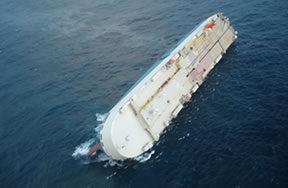
Car carrier Cougar Ace still afloat and holding at 60 degrees list, it says here. And, probably, except for an intervening storm, the ship will probably stay afloat until salvage crews arrive to tow her. I note from prior photos that her screw was out of water, so self propulsion not likely in her current position.
Some rescue photos here.
UPDATE: Faulty ballast tank shift at fault? Owner says so here:
The owner of a cargo ship that was crippled when it listed almost completely on its side said Wednesday that the problem occurred when its ballast tank was adjusted in the open seas of the North Pacific.4700 Mazda cars hang in the balance. Zoom.
***
The mishap appeared to have been caused by insufficient stability within the vessel, not by a collision or outside flooding, said Greg Beuerman, a spokesman for Tokyo-based Mitsui O.S.K. Lines, which owns the 654-foot car carrier.
"There clearly was imbalance in the intake of ballast water. The company investigation ultimately will tell us what caused that imbalance," he said.
UPDATE2: And a primer on the Free Surface Effect. You know, just until the owner's investigation comes up with something.
Maritime Security: A "Real Missile Threat?"
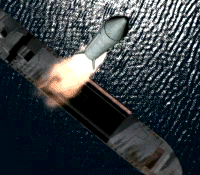
From a Washington Post commentary by James Jay Carafano of Heritage Institue, in which he deeply discounts the threat posed by North Korean ICBMs and the container packaged "nuke in a box" concern, he writes: Missing the Real Missile Threat:
If a country was serious about wanting to attack the United States with nuclear fire in a manner that would ensure surprise, leave no fingerprints and guarantee success, there's a much easier, better and cheaper way. It's one that could avoid the challenge of smuggling weapons into U.S. ports under the eyes of law enforcement, intelligence, customs officials and the Coast Guard: Put the missile on a ship disguised as a commercial freighter or private craft, sail near American waters and fire.This concept has been covered before- at The CounterTerrorismBlog here:
The North Koreans could adapt a short-range missile, such as a Scud. They already have them, and they know they work. The Scud has a large "throw-weight" (meaning it can carry a very heavy warhead) and could deliver a weapon at close range with ease. Building an improvised vertical launch platform for the missile is no significant technical challenge, nor is figuring how to make firing accurate enough to shoot a nuke at New York or Washington.
What's better (from an enemy's standpoint) is that the missile firing might well go undetected. Even tracing the perpetrator after the fact might be tough, particularly if the ship were scuttled after the firing. We wouldn't know who to retaliate against.
Now that's a real threat -- one we should take seriously.
Reader Timothy Thompson, who is always able to provide keen insight into weapons systems, comments on the missile purchase:Other relevant links here ("Iran's New Missiles"), here ("Iran's Cruise Missile Threat and Merchant Ships") and all the links therein. And remember that SecDef has mentioned this scenario before:
[The BM-25 missiles that Iran purchased] can easily be launched from [a] freighter modified with launch tubes and blast channels. They give Iran a projection of force capability far beyond the 2000-3000 km range of the missiles. It is possible -- though not confirmed -- that Iran may not use the BM-25's but only bought them to get the R-27 rocket motors for a missile of their own design.
Mr. Rumsfeld also was asked about the danger of terrorists or rogue states attacking the United States by putting a short-range Scud-type missile on a freighter and firing it close to U.S. shores.As long as I'm repeating things, go visit MissileThreat.com at the Claremont Institute and enjoy their movies of a merchant ship launch here (big) or here (smaller) to see how it would work.
He said one Middle East nation already has “launched a ballistic missile from a cargo vessel.”
“They had taken a short-range, probably Scud missile, put it on a transporter-erector launcher, lowered it in, taken the vessel out into the water, peeled back the top, erected it, fired it, lowered it, covered it up. And the ship that they used was using a radar and electronic equipment that was no different than 50, 60, 100 other ships operating in the immediate area.”
Other U.S. officials have said the nation was Iran, which tested a freighter-launched missile in the Caspian Sea in the late 1990s.
“It is true that the big distinction we make between intercontinental, medium-range and shorter-range ballistic missiles doesn’t make a lot of sense if you’re going to move the missile closer to the target,” he said. (source)
In short, Dr. Carafano is not raising a brand new issue with his comentary, but he does a service by keeping the issue alive.
UPDATE: Forgot to add about the EMP danger of a nuke exploding above our land mass. See "EMP Heard Again" which even has a quote from The Hertiage Foundation
An EMP attack damages all unprotected electronic equipment within the blast's "line of sight" (the EMP's "footprint" on the earth's surface). The size of the footprint is determined by the altitude of the explosion. The higher the altitude, the greater the land area affected. A Scud-type ballistic missile launched from a vessel in U.S. coastal waters and detonated at an altitude of 95 miles could degrade electronic systems across one-quarter of the United States.
Artwork of merchant ship missile launch liberated from MissileThreat.com.
UPDATE2: My version of a DPRK merchant hull with a SCUD TEL. The ship is the one intercepted by the Spanish Navy carrying SCUDs to Yemen as reported here.
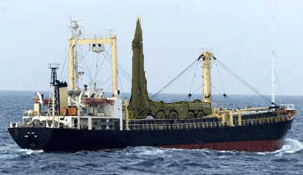
UPDATE3: Everybody scooped by China Confidential? See here for a report that the DPRK "May Have Helped Iran Test a Sea-Going Scud."
Tsunami Aid Pirates Arrested
Reported here:
The Indonesian navy has arrested three former separatist rebels for pirating ships carrying aid for tsunami survivors in the country's far-west Aceh province, a senior commanding officer said on Wednesday.
The three men, from two different groups, were caught in the north Aceh city of Lhokseumawe on July 18, two days after their latest operation, Rear Admiral Moekhlas Sidik, chief of the Indonesian Navy's Western Fleet, told reporters.
"We are still on alert for more action from their groups because they use weapons like rifles and grenade launchers in their operations," Sidik said.
Bubblehead gets weird mail
I like conspiracy theories. But somehow Bubblehead at The Stupid Shall Be Punished gets the good ones.
Though I am surprised he hasn't heard of the degaussing properties of merchant ships before...
Back to Weekly World News for me, after all, a T-Rex is terrorizing a trailer park...

Though I am surprised he hasn't heard of the degaussing properties of merchant ships before...
Back to Weekly World News for me, after all, a T-Rex is terrorizing a trailer park...

First half 2006 Piracy totals
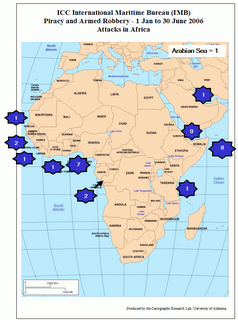

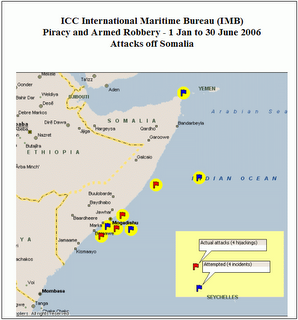
Reported here as Pirates are back on the map:
The Piracy Reporting Centre at the International Maritime Bureau listed 127 pirate attacks worldwide in the first six months of this year, the same as in the previous six months.The Strait of Malacca's rate of piracy slowed, but Somalia, Indonesia and Bangladesh are trouble spots.
***
The report said that 6 seafarers were killed, 156 crew members were taken hostage and 13 were kidnapped. A total of 74 ships were boarded by pirates and 11 were hijacked. Indonesia recorded 33 of the incidents, Bangladesh had 22 and Somalia had 8.
Nice maps from here
Cruise ship "tilt" due to human error
Remember the sudden change in course of the cruise ship that caused it to heel over so much that passengers were injured? It's now reported here as due to "human error":
UPDATE: After thinking it over, if I were the cruise ship company, I probably would prefer the "human error" causation to any sort of random computer glitch or mechanical malfunction. In some cases, the human factor is easier to fix.
Human error caused a cruise ship to abruptly tilt at sea last week, sending furniture and debris flying about the vessel and injuring 240 passengers, a cruise-line official said.
Though federal investigations continue, Princess Cruises president Alan Buckelow wrote in a letter to passengers that "the incident was due to human error and the appropriate personnel changes have been made."
UPDATE: After thinking it over, if I were the cruise ship company, I probably would prefer the "human error" causation to any sort of random computer glitch or mechanical malfunction. In some cases, the human factor is easier to fix.
Tuesday, July 25, 2006
Somalia- No talks unless Ethiopia walks

The Islamic Courts announce their peace talk terms:
Islamic courts controlling the Somali capital will not take part in talks with the government unless Ethiopian troops leave Somalia, an official says.
Earlier, Somalia's interim government agreed unconditionally to hold peace talks with the Islamists.
Talks to try and avert conflict between the two sides broke down last week.
The Union of Islamic Courts has vowed to expel Ethiopian troops who are deployed in Baidoa to assist the weak transitional Somali government.
"There is a condition for talks: as long as the enemy is in our country it will be impossible to sit down together and hold talks (with the transitional government)," Sheik Hassan Dahir Aweys, Chairman of the Islamic courts' consultative council told the BBC Somali service.
"We want the Ethiopian government, which has invaded Somalia and threatened Somalia, to leave our country, so that we can hold talks."
Latest ICC CCS Piracy Report (to 24 July 06)
Latest ICC Commerical Crime Services Piracy Report (to 24 July 06) is here. Very quiet week with only four reports of robberies, all while vessels were at anchor. Congo, Bnagladesh, Angola & Indonesia earn the honors.
Cougar Ace Follow-up
As reported here, the crew of the stricken Cougar Ace has been rescued and the ship abandoned. Earleir report here.
Photo by PETTY OFFICER JOSEPH ZEMCHAK / U.S. Coast Guard
UPDATE: Much credit to the Coast Guard and Air Force for taking care of the crew.
 Report:
Report: The Cougar Ace had been carrying cars from Japan to Canada when it began tilting to its port side late Sunday night. The crew sent out an SOS, but the nearest Coast Guard ship was a day's journey away.
By the time a Coast Guard aircraft arrived and was able to drop three life rafts for the crew Monday morning, the ship was at an 80 degree angle, nearly on its side, officials said. The roiling waters shoved the rafts underneath the dipping port side of the ship before the crew could secure them.
Rescuers tossed another raft toward the higher starboard side, but it was a 150-foot drop to the water.
A merchant marine ship crew that was nearby was unable to rig a line to the cargo ship, and the Cougar Ace's crew was losing power in its hand-held radio.
The helicopters appeared to the crew's best chance for survival.
"We made the decision to cram in everybody," said Master Sgt. Sal Provenzano with the Alaska Rescue Coordination Center.
In a daring rescue, the crew members, who had donned survival suits aboard their troubled ship, were hoisted Monday night into two National Guard Pave Hawk helicopters and a Coast Guard helicopter, then flown 230 miles north to Adak Island. One crew member with a broken ankle was to be flown by plane to Anchorage, Provenzano said.
H-60 Pavehawk info here
Monday, July 24, 2006
A piece of military history -sorta
It's 1972. Off the coast of Vietnam, thousands of American sailors are working in the heat of tropical sun and humid nights to support gunnery and air missions. On off nights, movies are shown to the crews of the ships.
The movies came from the Navy Motion Picture Service which was essentially a library of movies that could be checked out by a ship. Movies could also be transferred from ship to ship. The "movie officer" had a tough job - trying to meet the entertainment needs of young sailors for weeks at sea. And the pool from which to select was not deep. It seems to me that most movies were a few years old and were generally of "B" quality. Spaghetti westerns, John Wayne movies and comedies were welcome. Not too often were deep psychological films well-taken. Some movies transcended all the others and were exceptionally valuable trading material due to their high demand.
Now, remember, it's 1972. It's the year Jane Fonda visits North Vietnam. It's also the year of the April Offensive, when the NVA came rolling across the DMZ with beaucoup tanks. The Navy got busy with gunfire and air support for the South Vietnamese Army. The Navy mines the harbors of North Vietnam. Many Navy ships end up off the coast of Vietnam.
 .
.
You also have to remember that in 1972 there were no VCRs, no DVDs. Movies were just film, run on projectors.
Got the picture? Well, here's another bit of Navy history probably rarely, if ever, recorded until now. The most highly sought after film on the ships off Vietnam in 1972 was a Jane Fonda film.
That's right, the same Jane Fonda.
And the movie was Barbarella.
And, as can be seen at Barbarella Headquarters, the reasons were not the acting performances of Ms. Fonda or John Phillip Law. Nope. The popularity was due to the costumes more or less (mostly less) worn by the actresses. So, in an ironic twist, Ms. Fonda was helping morale at the same time she was, well, trying to hurt morale.


Of course, the movie was released in 1968, so it was old enough to be in the Navy system (we never got first run movies). Now, I understand that a remake is in the works, this time starring Drew Barrymore.
I hope our current warriors enjoy the new version.
(Blog sweeps? Over to you, Lex)
UPDATE: Oh, yeah, it was also the last Jane Fonda movie I have ever seen.
UPDATE2: Time-Life proof.
The movies came from the Navy Motion Picture Service which was essentially a library of movies that could be checked out by a ship. Movies could also be transferred from ship to ship. The "movie officer" had a tough job - trying to meet the entertainment needs of young sailors for weeks at sea. And the pool from which to select was not deep. It seems to me that most movies were a few years old and were generally of "B" quality. Spaghetti westerns, John Wayne movies and comedies were welcome. Not too often were deep psychological films well-taken. Some movies transcended all the others and were exceptionally valuable trading material due to their high demand.
Now, remember, it's 1972. It's the year Jane Fonda visits North Vietnam. It's also the year of the April Offensive, when the NVA came rolling across the DMZ with beaucoup tanks. The Navy got busy with gunfire and air support for the South Vietnamese Army. The Navy mines the harbors of North Vietnam. Many Navy ships end up off the coast of Vietnam.
 .
.You also have to remember that in 1972 there were no VCRs, no DVDs. Movies were just film, run on projectors.
Got the picture? Well, here's another bit of Navy history probably rarely, if ever, recorded until now. The most highly sought after film on the ships off Vietnam in 1972 was a Jane Fonda film.
That's right, the same Jane Fonda.
And the movie was Barbarella.
And, as can be seen at Barbarella Headquarters, the reasons were not the acting performances of Ms. Fonda or John Phillip Law. Nope. The popularity was due to the costumes more or less (mostly less) worn by the actresses. So, in an ironic twist, Ms. Fonda was helping morale at the same time she was, well, trying to hurt morale.



Of course, the movie was released in 1968, so it was old enough to be in the Navy system (we never got first run movies). Now, I understand that a remake is in the works, this time starring Drew Barrymore.

I hope our current warriors enjoy the new version.
(Blog sweeps? Over to you, Lex)
UPDATE: Oh, yeah, it was also the last Jane Fonda movie I have ever seen.
UPDATE2: Time-Life proof.
An Army guy goes messing about in boats
John of Castle Argghhh!!! goes in for a sea adventure as he sets out here in fine James Michener style here. Essential theme: "Or how a retired artilleryman found himself traveling to Mexico to help repatriate a US WWII Fletcher-class destroyer back to the United States."
Go, read, enjoy and wonder whether Josephus Daniels' rules pertaining to libation will apply.
Go, read, enjoy and wonder whether Josephus Daniels' rules pertaining to libation will apply.
Maritime Monday 19 at Fred Fry International!
Excellent roundup of things nautical at Fred Fry International: Maritime Monday.
Car smuggling by sea from Singapore

Reported here:
"Every car smuggler taking cars coming into Batam from Singapore must wait for the high tide because it allows the boats to dock at the beach, something that people don't expect," Sumandi said. Each large vessel carried seven to 12 cars, he said.The Riau Islands are part of Indonesia. Batam is across the Singapore Strait from Singapore.
It is an open secret that the local police, the Navy, the Army and the customs office are behind the smuggling of the used cars from Singapore into Batam.
These smuggling operations have grown in size since the beginning of the reform era, with importers now competing to bring in cars illegally.
Ship in trouble off Alaska


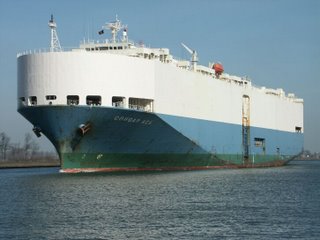
Reported here:
A crewmember from the Singapore based container ship Cougar Ace, a car carrier with 23 people on board, contacted the North Pacific Search and Rescue Coordination Center at 11:09 p.m. Sunday. He reported that they were taking on water and listing 80 degrees.U.S. Coast Guard ship enroute, C-130 overhead:
The Cougar Ace is currently located about 230 miles south of the Aleutian Island Chain, in the middle of the North Pacific Ocean.
A Coast Guard C-130 plane was circling over the Cougar Ace, which sent out an SOS late Sunday night, Petty Officer Stephen Harrison said. A Coast Guard cutter was on its way to the site, 230 miles of the Adak in the western Aleutians.UPDATE: New report here says liferaft has been dropped by C-130 and the other merchant ship has a line over to the Cougar Ace to try and halt the listing:
A merchant ship in the area also was heading to the site and expected to arrive shortly, Harrison said.
The 654-foot ship, which had been carrying cars from Singapore to Canada, but was at an 80 degree angle to the water Monday morning and appeared to be leaking oil.Massive load shift? Great big wave strike?
"It's sitting on its side, basically," Petty Officer Stephen Harrison said.
A merchant marine ship that had been in the area was trying to rig a line to the Cougar Ace to keep it from tilting futher, while the Coast Guard worked on a way to get the life raft, which landed some distance way, to the crew, said Petty Officer Thomas McKenzie. All 22 crew members were wearing survival suits, officials said.
UPDATE: Latest report here says helos enroute with refueling plane and another C-130. Crew ready to abandon ship.
Gone in 60 Seconds? Grand theft ship
One way of evading the enforcement of legal consequences is to run off. This is apparently the case here:
UPDATE: Cruel Kev had the story early. Hat tip: Fred Fry International.
UPDATE2: South Africa denies the ship was South African:
Namibian security forces have abandoned the search for a SA-registered container vessel, MV Umfolozi, which was reported stolen a week ago.The old "testing the engines" trick works again.
It is believed that the 133-metre-long ship is headed northwards, possibly to Russia.
The Umfolozi had been docked at Walvis Bay since September last year, after a collision with another SA-registered vessel, the dredger MV Ingwenya, belonging to the SA National Ports Authority.
***
The ship was refloated on July 15 and went missing after its captain, Alexander Saleh, radioed a false report of engine trouble while ostensibly conducting engine trials.
UPDATE: Cruel Kev had the story early. Hat tip: Fred Fry International.
UPDATE2: South Africa denies the ship was South African:
A container ship stolen from the Walvis Bay harbour in Namibia is not a South African vessel, the South African Maritime Safety Authority (Samsa) revealed today.UPDATE3: A report on the "mystery deepening"here:
"The ship is not registered on any of our (South African) rolls at all," said Saleem Modak, Samsa's captain. It reportedly docked in Walvis Bay in September after a collision with the South African-registered dredger, the MV Ingwenya, while on its way to Cape Town with 335 tons of fuel on board. Originally called the MV Umfolozi, it was renamed the Michael S and sold to the Greek ship-owner, Alexander Saleh, after it was repaired.
The Umfolozi made headlines in September last year when it sank in the Walvis Bay harbour after colliding with a South African dredger.Doesn't sound all that mysterious.
After it was repaired and refloated, the Umfolozi was rechristened the Michael S and was sold to a Greek ship owner, Alexander Saleh, who, it is being alleged, is responsible for spiriting away the ship.
Crew members are alleged to have boarded the ship under false pretences, held two security guards captive and later dumped them and their belongings overboard.
It is alleged that Saleh boarded a plane at Windhoek's Hosea Kutako International Airport on the same day.
Approached for comment, Gusev confirmed to The Namibian that he had been notified of his suspension yesterday morning, and that it was related to the theft of the Umfolozi.
Carriers attacked
Probably a good idea to occasionally question the way you are doing business as is the case reported in this article: Navy's use of big carriers again being questioned
I predict the end result will be "no change."
I predict the end result will be "no change."
Ship insurance rates to rise in Middle East
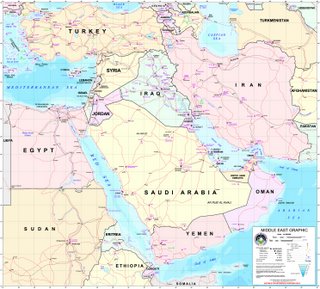
Reportedhere:
With the worsening conflagration in Lebanon-Israel and the resulting consequences for maritime traffic, ship operators are bracing themselves for a hike in war risk insurance premiums for vessels that transit the Eastern Mediterranean.
The 12-member Europe Mediterranean Trade Agreement that includes A.P. Moller-Maersk, Mediterranean Shipping Company and CMA CGM issued a statement: "In the event that extra costs do arise for war risk insurance, the lines wish to inform their customers that they will have no option but to pass these on to customers by way of a war risk surcharge with immediate effect".
***
The US National Geospatial-Intelligence Agency has also issued a warning that due to 'armed conflict' Israeli naval ships have established a closure area in the Eastern Mediterranean Sea off the coast of Lebanon (between 34-05N and 33-06N and between 034-00E and the coastline). Ships will not be allowed to enter or exit the area and all commercial vessels are being advised to keep well clear of the specified zone.
Interesting thoughts: The Wedgie in the Middle East
Nice commentary by a retired US Navy officer on The Wedge as Tactical Tool: What is Hezbollah Doing and What is the US Strategy?.
UPDATE: Is this the same John E. Carey? If so, well...it doesn't mean his assessment in all things is flawed.
Iran's strategy for international relations can be summed up in these three simple words: wedge, isolate and destroy. Iran chose this strategy to deal with the most heinous place and people it can imagine on earth: Israel and the Jews. Iran uses this strategy in its dealing with the UN. And we see this strategy applied to relations with "the Great Satan," the United States.The author is identified as John E. Carey whose blog Peace & Freedom is also recommended.
Often nations use the wedge as a tactic to divide allies arrayed against them in hopes that this divided counter-force will make the principal enemy subject to isolation and destruction. How Iran and Hezbollah plan to isolate and destroy Israel, especially given the strong and historic support from the United States, remains to be seen. But we are seeing evidence of the use of wedge tactics in Hezbollah and Iranian actions as well as the US response.
UPDATE: Is this the same John E. Carey? If so, well...it doesn't mean his assessment in all things is flawed.
Sunday, July 23, 2006
Kosovo: Revisiting the mess

Nice summary of the mess left behind by the Kosovo intervention in The American Spectator here. Hatred, poverty and stupidity are not good foundations for a country.
Kosovo is an unpleasant bit of unfinished business that the West would prefer to forget. A fair and sensible resolution is well nigh impossible, especially since the behavior of Washington and NATO has been truly disgraceful. Far from creating a tolerant democracy, the allies have presided over one of the largest episodes of ethnic cleansing in the Balkans. And if the U.S. continues on its present course, virtually everyone expects the ethnic majority to complete the job in just a few more years, if that long.The U.S. maintains about 1700 troops in Kosovo as part of the 18,000 member KFOR. This somewhat after the "They'll be home by Christmas" deadline set by President Clinton.
Like most of the Balkans, the problem of Kosovo goes back centuries. Serbian identity is rooted in both Kosovo's military history, particularly the 1389 defeat by the Turks in the Battle of the Blackbirds, and spiritual significance, represented by ancient churches and monasteries.
***
In any case, Western officials, starting with American Secretary of State Madeleine Albright, developed policy in a dream world. They thought that a couple days of bombing would bring Belgrade to heel, completely missing the nationalism that animated most Serbs, even democrats and human rights advocates. Worst, the allies believed that they would be able to concoct a multi-ethnic Kosovo in which Albanians and Serbs would join hands singing Kumbaya around communal campfires. In fact, having used their American-supplied air force to eject the Serb military units, the victorious ethnic Albanians saw no need to compromise.
After the war -- under the occupation of the West -- the Albanian community kicked out a quarter million Serbs, Roma, Jews, and non-Albanian Muslims. Over the next five years isolated Serbs were killed, beaten, and kidnapped. Even Serbian enclaves were vulnerable to drive-by shootings.
The opinion piece does not mention that lives were saved by the intervention, or that the Kosovar Albanian agenda was not "peaceful" coexistence with the Serbs, but rather (1) revenge (and the memories are long in Kosovo) and (2) independence from Serbia (why would you want to be part of a country that had a history of ethnic cleansing against you). The author gets the Plain of Blackbirds (Kosovo Polje) thing right from the Serbian point of view. In 1989, Milosevic held a huge rally there at the big monument to fire up Serbian nationalism.
UPDATE: Oh, yes, the Kosovo economy stinks, too. According to this (pdf) unemployment is over 51%. Whoo hoo.
Sunday Ship History: Behold the LMSR

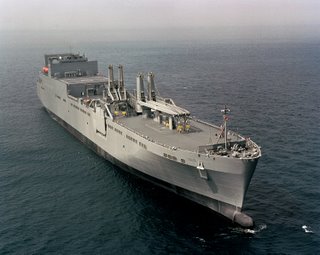

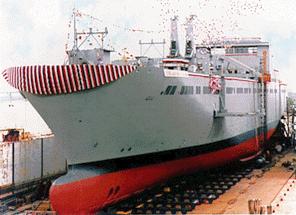
Modern military logistics includes the need for large quantities of material and equipment to be delivered in a hurry and in operating condition. One solution to the problem of filling that need has been the use of the RoRo, or "Roll On- Roll Off" ships.
Anyone who has ever driven a car onto a ferry has seen the concept of RORO in action.
You drive on and you drive off. But modern military ROROs hold a little more than the average ferry. For example, a US Large, Medium Speed Roll on/Roll Off (LMSR) ships hold the following:
*Each LMSR can carry an entire U.S. Army Task Force, including 58 tanks, 48 other tracked vehicles, as well as more than 900 trucks and other wheeled vehicles.What's that give you when you need to apply force somewhere?
* The LMSRs are each crewed by approximately 30 civilian mariners who work for private companies under contract to the Military Sealift Command.
* The ships support both combat and humanitarian missions.
* Bob Hope-class, Watson-class and Shughart-class ships each have a cargo-carrying capacity of more than 300,000 square feet, equivalent to more than five football fields.
* Each LMSR has a slewing stern ramp and a removable ramp that services two side ports, making it easy to drive vehicles on and off the ship.
* Interior ramps allow easy traffic flow between decks.
* Two single pedestal twin cranes which can jointly lift 110-tons make loading and off-loading possible where shoreside infrastructure is limited or nonexistent.
* A helicopter deck allows for emergency landings.
The eight LMSRs dedicated to prepositioning can carry enough ammunition, food, water, fuel, equipment and other supplies to sustain up to 20,000 troops of an Army 2x2 heavy armored brigade for up to 15 days. These ships preposition U.S. Army equipment and supplies principally in the Indian Ocean.Of course, the LMSR is just part of the US Afloat Prepositioning Force that also includes the Maritime Prepositioning Ships (MPS) that provide the US Marines support as follows:
One squadron of MPF ships can provide all the equipment and supplies to support a U.S. Marine Expeditionary Brigade of about 15,000 personnel for 30 days. The ships are capable of off-loading at piers or offshore with special lighterage equipment. Each ship has roll-on/roll-off capability and a flight deck for helicopter operations.In other words. given the airlift to get the troops in place, the US could put 35,000 Marines and soldiers in place and mission-equipped for extended operations in a hurry. The importance of this prepositioned capacity set out here.
Thought you might like to know.
